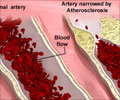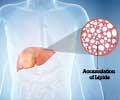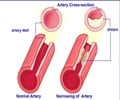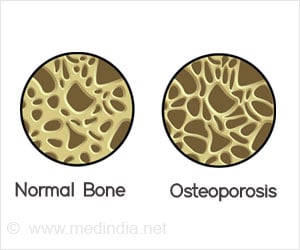According to a study, among eployed U.S. service members who died of combat or unintentional injuries the prevalence of coronary atherosclerosis was 8.5 percent.

Bryant J. Webber, M.D., of the Uniformed Services University of the Health Sciences, Bethesda, Md., and colleagues conducted a study to assess the prevalence of atherosclerosis in the U.S. armed forces. The study included all U.S. service members who died of combat or unintentional injuries in support of Operations Enduring Freedom and Iraqi Freedom/New Dawn between October 2001 and August 2011 and whose cardiovascular autopsy reports were available at the time of data collection in January 2012. Prevalence of atherosclerosis was analyzed by various demographic characteristics and medical history. Classifications of coronary atherosclerosis severity were determined prior to data analysis and designed to provide consistency with previous military studies: minimal (fatty streaking only), moderate (10 percent - 49 percent luminal [interior of the vessel] narrowing of one or more vessels), and severe (50 percent or more narrowing of one or more vessels). Of the 3,832 service members included in the analysis, the average age was 26 years.
The overall prevalence of coronary or aortic atherosclerosis was 12.1 percent. The prevalence of any coronary atherosclerosis was 8.5 percent; severe coronary atherosclerosis was present in 2.3 percent, moderate in 4.7 percent, and minimal in 1.5 percent. The researchers found that age consistently produced the strongest association with prevalent atherosclerosis. Service members with atherosclerosis (average age, 30.5) were approximately 5 years older than those without; those 40 years of age and older had about 7 times the prevalence of disease as compared with those 24 years of age and younger (45.9 percent vs. 6.6 percent)
Lower education level and higher military entrance body mass index (BMI) were significantly associated with prevalent atherosclerosis, after adjusting for age. As compared with those who completed high school or less, those who completed at least some college had lower prevalence of disease. As compared with those with a normal BMI on military entrance, those with a BMI in the overweight or obese range had a significantly higher prevalence of atherosclerosis
The authors also found that age-adjusted atherosclerosis prevalence was associated with several diagnoses. As compared with those with no major cardiovascular risk factor diagnoses, those with a diagnosis of dyslipidemia (50.0 percent vs. 11.1 percent), hypertension (43.6 percent vs. 11.1 percent), or obesity (22.3 percent vs. 11.1 percent) had a significantly higher prevalence of atherosclerosis.
The researchers note that the prevalence rates found in this study demonstrate a decline from the rates of 77 percent noted in the Korean War and 45 percent in the Vietnam War, but add that targets for further improvement remain.
Advertisement
Source-Eurekalert















